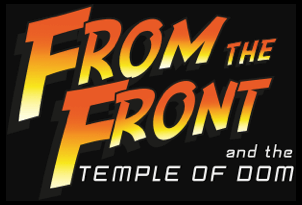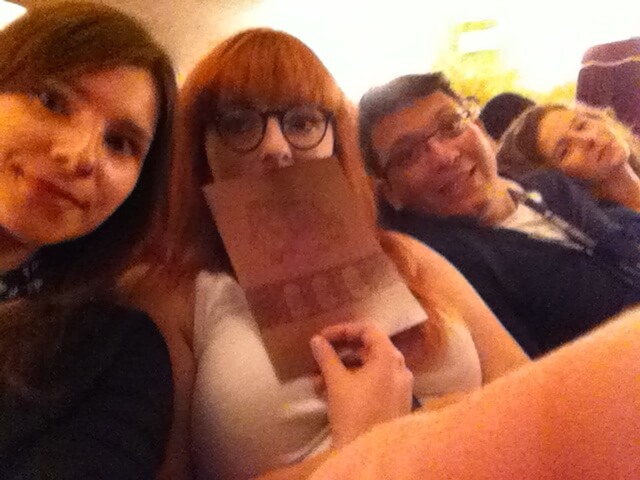Our Indiana Jones Front End Experience

September is definitely a conference season—most of our office is deserted and the ones left are looking forward to going somewhere themselves soon. Me (Anna), Julia, Małgorzata and Rafael decided to head to the beautiful city of Bologna (Italy) for From The Front and the Temple of DOM conference. Yes, you read this correctly and the name may seem familiar to you. The conference’s main theme was taken from the Indiana Jones movie and it made all of us even more excited. The organizers used the Indy theme to create great sponsor banners, beautiful schedules and dressed up the host, Pierre Spring, as Indiana Jones. Unfortunately even Pierre’s style was not enough to outshine the total awesomeness of the venue—Teatro Duse—which is basically magical. The only drawbacks of the place were the lack of WiFi connection and a bit too much darkness, but we quickly got over it and fully immersed into front-end talks of very high quality.
“It’s a long story. Better hurry up or you won’t get to hear it!”
The first day of the conference started with a great talk by Jeremy Keith who managed to rewire the brains of probably all the conference attendees. What he showed us was unbearable… Did you know that all ducks wear dog masks? Now switching to serious again: Jeremy pointed out that a big, innovative feature of the web is that it’s not a platform and it works anywhere. Or at least it works anywhere until we break it by relying on technology that can fail. Nowadays we often have pages that depend on JavaScript to such an extent that they don’t even display basic HTML elements when it’s disabled. And that’s just wrong. So when building our websites, we shouldn’t be optimizing for any particular browser or system, and we shouldn’t completely disregard old browsers, as we often do. Instead, we should develop using progressive enhancement—start from the basics and add all the new fancy bits later, in a way that doesn’t break the experience for older browsers. As Andy Hume’s quote says, “Progressive enhancement is more about dealing with technology failing than technology not being supported”. But don’t worry, your page working everywhere doesn’t mean it has to look the same everywhere! It probably wont. Jeremy repeatedly asked the question: “Do websites need to look exactly the same in every browser?“. The answer couldn’t be anything else than a unanimous “NO” from the crowd.
Another thing I couldn’t wait for was Estelle Weyl‘s speech, “RWD is not a panacea“. I wanted to hear her newest findings, because I finished writing my master’s thesis just before the conference and used Estelle’s article to support some of my ideas in the process. I was not disappointed. Optimization tricks and the examples of truly slow mobile experiences made me realize how much some things need to change in the way people use images, scripts and all other heavyweight assets. It is not that your customers don’t use your website on mobile because they don’t need it… it is because the experience makes them give up after the first attempt! Thanks to Estelle, Julia already used this statement as a starting point for the conversation of the topic of RWD topic with one of our clients. So we are not slouching! Andre Jay Meissner‘s talk was focused on how to convince our customers to spend money on testing their product on different devices. Well, the option with including a testing budget in agreements sounds very enticing! Andre looks after LabUp!, a non-profit initiative that helps people open their own Open Device Labs. PS. Maybe we should look into opening one here in Cracow? Would anyone be interested in collaboration?
The first person to speak after the break was Gunnar Bittersmann, a very friendly, Polish-speaking (!) German who dedicated his presentation to CSS preprocessors. Specifically, using them to put into effect the OO concept and achieve reusable CSS code without paying for it with bloated, presentational markup. It was helpful and refreshing, as we in Lunar Logic are currently in the middle of preparing new CSS guidelines. Gunnar presented obvious drawbacks of using some of the conventions (such as for example ugly massive class concentration in OOCSS’s HTML) and reminded us that we should remember about separating Presentation (CSS) and Behaviour (JS). It might seem obvious to some of developers, but unfortunately is quite often a forgotten rule and we end up seeing awful, unnecessary style modifications done with JavaScript. For sure we will try Sass placeholders, mixins and extends mix after hearing your reasoning, Gunnar!
When it comes to responsibility, we might often try to escape it and just create websites that look great but are not bulletproof. Sally Jenkinson reminded us that it is our responsibility to get everything right and strive for the best experience possible for our users. The last, but not least, presentation this day was prepared by Owen Gregory. His speech was perfectly edited and prepared, I felt as though I was watching an actor’s performance on the stage of Theatro Duse. The main purpose of this talk was to encourage all writers (me writing the blog post, you writing a tweet, someone writing a Readme file for GitHub) to master the art of composing beautiful pieces of written word. The slides were minimalistic and well thought, speech encouraging and sophisticated. I am glad that such people find their way to front-end conferences and inspire to strive for perfection. After the presentations we headed for the conference party. Though the place was not perfect (only one stand with 3 types of beers, plastic cups, outdoor and a bit weird) we could use the opportunity to share our ideas about the conference with the speakers themselves and have some time to talk to people responsible for oragnizing the conference. It was cosy!
“You’re meddling with powers you can’t possibly comprehend.”
Jon Gold kicked off the second day of the conference with his anti-unicorn campaign. Well, he wasn’t exactly against real unicorns or people in programming world who are so rarely multi-skilled that they are called unicorns, but was trying to go against applying the term “unicorn” to people. He also pointed out the difficulty in listing all our areas of specialization (because there is no word to name all these jobs at once, this was Indiana Jones’ problem as well: “Professor of Archaeology, expert on the occult, and how does one say it… obtainer of rare antiquities.”) and proposed to call ourselves web makers and creators of the web. This actually makes a lot of sense (and sounds less stupid than the name of a mythical horse with a horn in its forehead) to put as my job description. I also got to realize that it is ok to be good in many things as well as it is ok to be excellent in one thing. By the way Jon is excellent in speaking and good in many other things so I don’t know if it is still fair. ;)

Later the same day the three awesome women had their time on stage: Jenn Lukas, Sara Soueidan and Ulrika Malmgren. Each one of them rocked so much that any person implying that women don’t fit IT related jobs should shut up and crawl under their rock to hide. Jenn told us about meaningful animations and problems with touchscreens that might be a result of using :hover. Her talk was funny, cat-powered and enlightening. I suggest to watch it when the video appears instead of reading about it. Actually you should watch all of the videos to get a whole lot of inspiration from the conference. And probably the most inspiring was to see Sara Soueidan starting her presentation even without her slides (due to technical problems) and knowing by heart what was on them. It was amazing! I haven’t seen anyone being so professional in a long time! Her presentation was the greatest concentration of all knowledge you might ever need on the SVG topic and demanded a standing ovation. You can check the slides yourself, but be sure to also watch this amazing performance. The third of rocking women was Ulrika, who presented us with very practical and easy to try techniques for testing our projects. From doing the regular checks and mind maps to seeing moonwalking bears, Ulrika was our guide in the topic of testing for 45 minutes and probably saved many apps from being buggy in the future.
The last presentation of the conference was by great Christian Heilmann. Probably its title (“Rubbing the Sankara stones the wrong way”) gives you a hint already—it was full of Indiana Jones references. I must admit that the short clip from the movie narrated by Christian was probably the funniest thing I have seen at this conference. The talk covered many problems, that web struggles today and there is a wonderful blog post with notes on that by Christian himself, so I don’t think any additional comments are necessary.
“And what did you find?” “…Me? Illumination.”
To sum up, the conference was great. The talks were truly of high quality, the venue was beautiful and made it easy to approach people you really wanted to talk to and even the conference food was delicious (vegetarian option included! Me, Gosia and Julia don’t eat meat and didn’t have to starve as it happens sometimes). I will definitely try to head there again and sight-see Italy some more. Thank you all for such a great time and the unimaginable amount of knowledge we had a chance to grasp.

